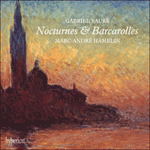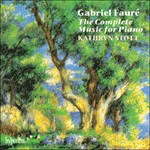‘Hewitt's way with the Valses-caprices is scintillating and extrovert, most notably in the second waltz's swing-high, swing-low teasing sophistication … she is notably sensitive, too, to the openings of Nocturnes Nos 6 and 13, and to the latter's anguished utterance … Hewitt's excellently recorded disc (as bright as the playing) provides an invigorating modern alternative’ (Gramophone)
‘Take a French composer with a contrapuntal bent, whose music requires a rigour, poise and nuance akin to that of a ballet dancer. Then choose a pianist, such as Angela Hewitt, whose feel for all these qualities is a given. The result is an exquisite Fauré recital … Hewitt's clarity is exemplary. The purity and strong, supple backbone of her playing lets Fauré's inventive genius, his extraordinary sensitivity to colour, harmonic shading, texture and eloquence, shine on its own terms’ (BBC Music Magazine)
‘It is strange how little of Fauré’s piano music seems to be part of the regular repertoire nowadays compared with, say, Debussy or Ravel. It is even stranger when you hear it played with such captivating élan and finesse as by Angela Hewitt. With her radiant sparkle in two Valse-caprices, the sun seems to shine, and she traces a whole rainbow of moods through three nocturnes (Nos 5, 6 and 13), the early Ballade and the Thème et variations Op 73. Utterly delightful’ (The Daily Telegraph)
‘Those unfamiliar with Fauré's keyboard works will find that Hewitt's selection provides a perfect introduction, She is complemented by a fabulous recording quality and an instrument (her trusty Fazioli) that does her justice at every turn’ (International Record Review)
‘A very thoughtfully planned sequence, beautifully executed; the sharply contrasting characters of each of the variations are perfectly focused, while the joyous exuberance of the early Ballade sweeps all before it. She's equally precise and revealing in the apparently slighter works, too, finding just a hint of the danger that gives the French waltz its special edge in the Valses-caprices, and including two of the greatest of the nocturnes: the sixth in D flat major and the 13th in B minor, Fauré's last and profoundly tragic piano work. All these pieces are presented with exemplary clarity and wonderfully crystalline tone’ (The Guardian)
‘Hewitt knows that some regard the composer’s Nocturnes, Ballade, and Theme and Variations Opus 73 as 'salon' music, and sets out to prove that these short pieces are as complex and nuanced at heart as they are serene and accessible on the surface. Particularly masterly are the variations, the heartbreaking 7th and final 12th very lovely’ (The Independent on Sunday)
‘A thoughtful and satsifying Fauré selection traversing his career and showing his art in diverse hues … Hewitt's interpretations are powerful and poetic’ (The Sunday Times)
‘Hewitt brings not just an intimate grasp of the music’s harmonic and technical demands, but an essential refinement—most evident in the Theme and Variations, in which she finds élan, lightness and grandeur without overemphasising the differences between the 11 variations. As for the Valses-caprices, you can’t mistake Hewitt’s delight in the playful passage-work’ (Financial Times)
‘Angela Hewitt is totally sympathetic to Fauré's sometimes elusive world and her Fazioli piano is superbly recorded’ (Liverpool Daily Post)

 Fauré: Nocturnes & Barcarolles
Fauré: Nocturnes & Barcarolles Fauré: The Complete Music for Piano
Fauré: The Complete Music for Piano
